Tutorial¶
To start your own Dapp, open the dapps menu by pressing ‘d’ or ‘D’ within the shadowlands application.
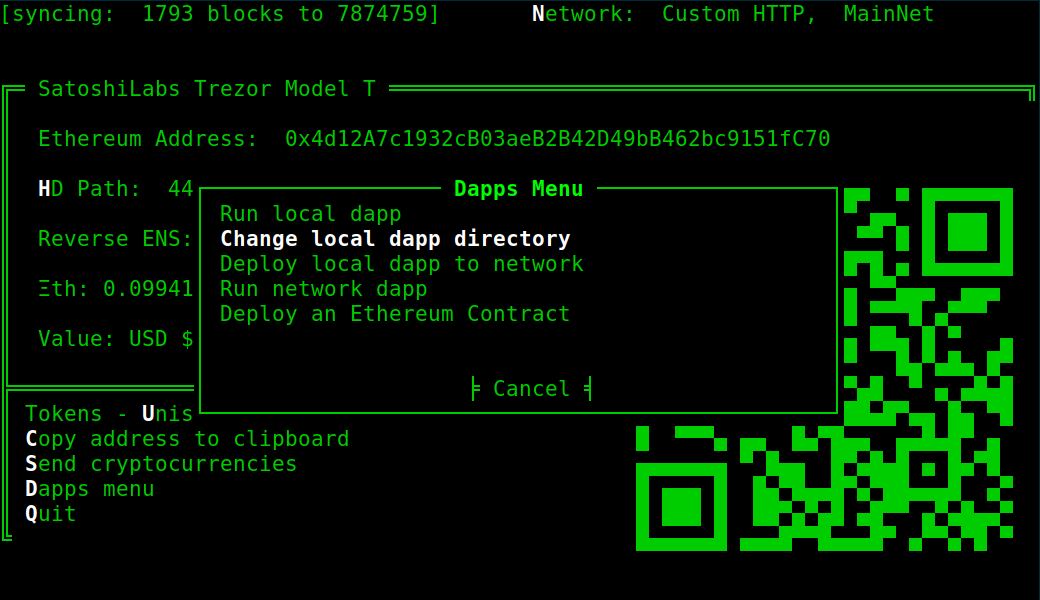
Next, set the local dapp directory to your desired location.
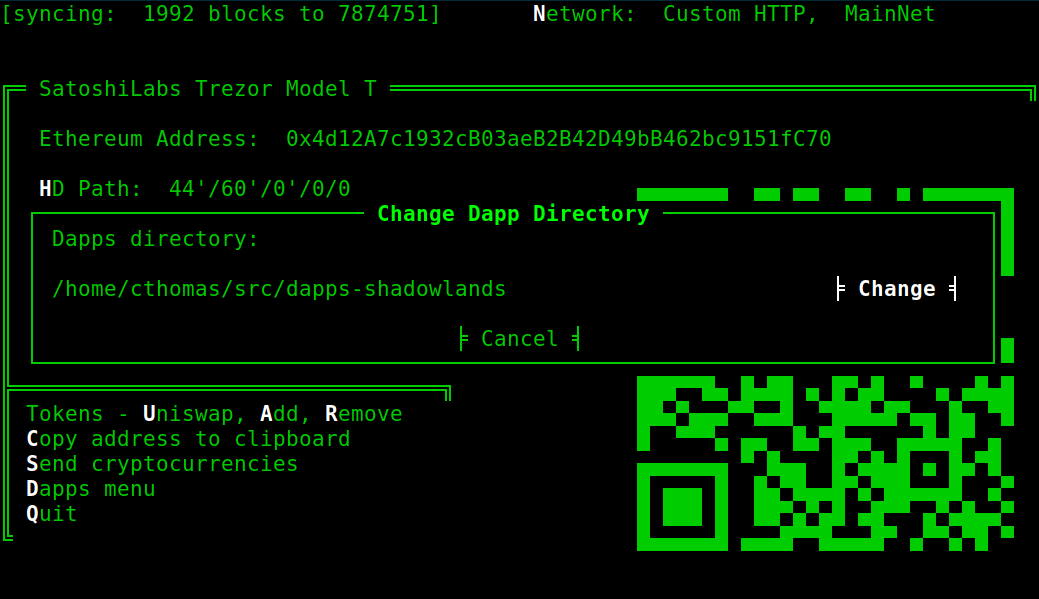
Inside your chosen local dapp directory, create a new subdirectory with the name of your dapp. Inside, create a file called __init__.py.

Your first SLDapp¶
For our example, let’s become Trogdor the Burninator, the wingaling dragon. We will burninate peasants in the kingdom of peasantry. In our case, peasants will be BRNT (Burninator tokens) visible at token.burninator.eth)
from shadowlands.sl_dapp import SLDapp from shadowlands.sl_frame import SLFrame from shadowlands.sl_contract import SLContract class Dapp(SLDapp): def initialize(self): # Define any variables that will be useful to you, such as contracts. # Any other setup steps go here # add a frame to begin the user interface self.add_sl_frame(MyMenuFrame(self, height=5, width=40, title="Trogdooooor!")) class MyMenuFrame(SLFrame): def initialize(self): self.add_divider() self.add_button(self.close, "Close")
Import SLDapp at the top of your __init__.py file in your dapp’s subdirectory. We’ll also import SLFrame and SLContract.
Create a class named Dapp that subclasses SLDapp. The class must be named Dapp in
order for the shadowlands plugin system to detect your dapp.
Override the
SLDapp.initialize() method, and do any necessary preperation within. Then, add an SLFrame subclass (which you need to provide) with SLDapp.add_sl_frame(). This step begins the user interface.
The line self.add_sl_frame(MyMenuFrame(self, height=5, width=40, title="Trogdooooor!")), referenced from initialize(), will load an SLFrame instance with the listed parameters when the dapp loads.
Like SLDapp instances, SLFrame instances execute initialize() when they are created, and you must implement this abstract method. Our SLFrame will add a one-line divider with self.add_divider() and then add a close button with self.add_button(self.close, "Close"). The first parameter to self.add_button is a function to be executed upon the button press action, in this case self.close().
Now, let’s run our first dapp. Open the dapps menu and choose to run a local dapp:
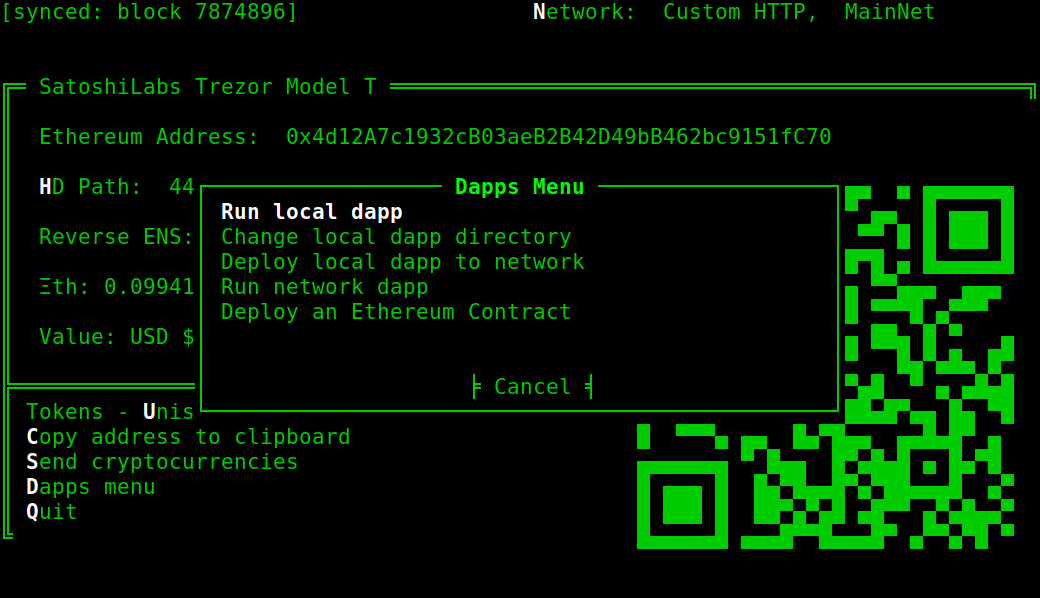
Now, choose your dapp from the list:
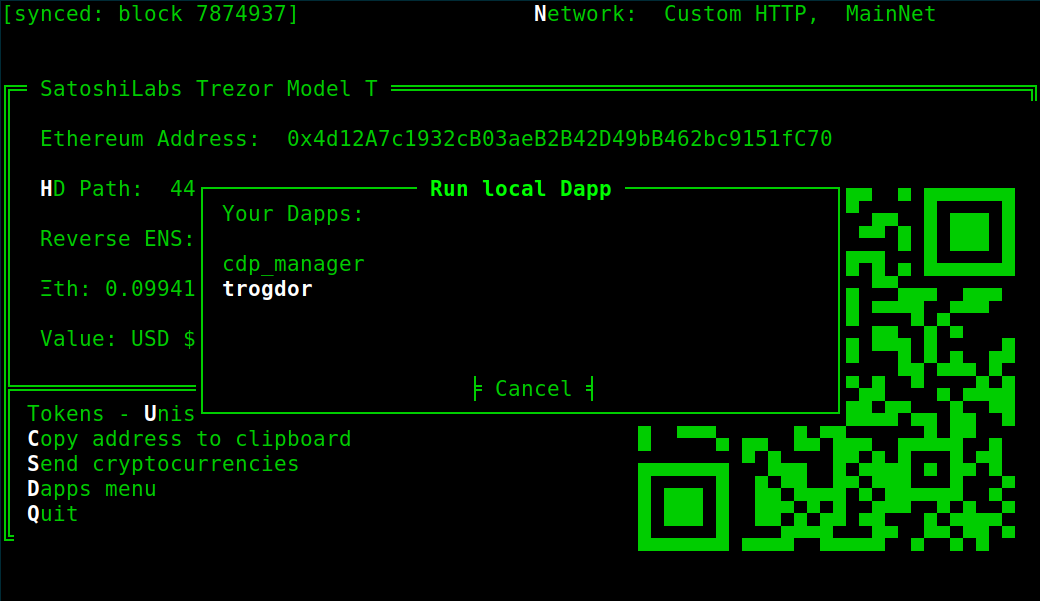
And this is the output:
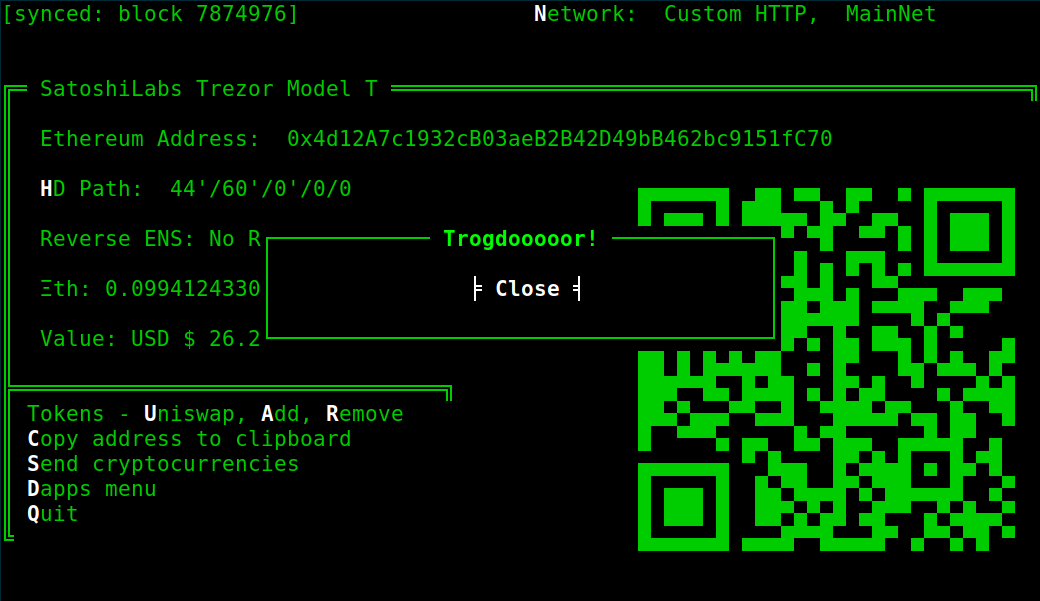
Debugging¶
Now, let’s make a few changes.
from shadowlands.sl_dapp import SLDapp
from shadowlands.sl_frame import SLFrame
from shadowlands.sl_contract.erc20 import Erc20
from shadowlands.tui.debug import debug, end_debug
import pdb
class Dapp(SLDapp):
def initialize(self):
# Define any variables that will be useful to you, such as contracts.
# Any other setup steps go here
debug(); pdb.set_trace()
PEASANT_ADDRESS = '0x8B654789353b0B622667F105eAEF9E97d3C33F44'
peasant_contract = Erc20(self.node, address=PEASANT_ADDRESS)
self.add_sl_frame(MyMenuFrame(self, height=5, width=40, title="Trogdooooor!"))
# add a frame to begin the user interface
class MyMenuFrame(SLFrame):
def initialize(self):
self.add_divider()
self.add_button(self.close, "Close")
Here you can see we’ve set up some debugging tools with a few import statements. The functions debug() and end_debug() will give us a way to escape from the curses library that’s controlling the screen and let pdb work.
You can also see I defined PEASANT_ADDRESS which is the ethereum
mainnet address of a simple ERC20 contract. We load the contract with
the Erc20(self.node, address=PEASANT_ADDRESS) constuctor. self.node is a reference to the Node object that the Dapp object has
access to.
The important line debug(); pdb.set_trace() is something you should
become familiar with when writing a shadowlands app. Running pdb without
escaping from the user interface will be a maddening experience, so don’t forget to run debug() before you get pdb running.
Now, when you run your dapp, you’ll see:
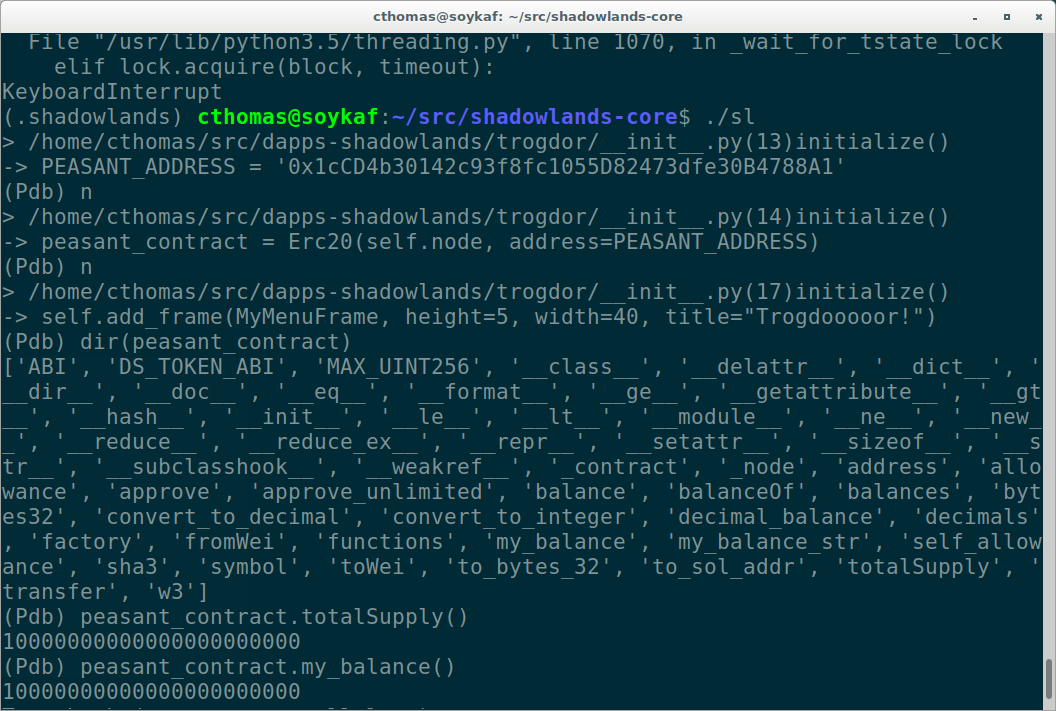
Here you can see some of the methods that the Erc20 class provides. You can also access the underlying web3.py contract object by accessing peasant_contract._contract.
To escape from the debug session and get back to your app, type end_debug();; continue. This incantation will restore control of the screen to the curses library and end the session.
Requirements File¶
You can include a requirements.txt file in your dapp directory to import modules that you might need.
They will be installed into Shadowlands’ python virtual environment at ~/.shadowlands when the dapp runs
on the host system.
There’s no library dependancy in this tutorial, I just wanted to mention it.
Handling user input¶
Let’s get some user input and do something, er… useful?
from shadowlands.sl_dapp import SLDapp
from shadowlands.sl_frame import SLFrame
from shadowlands.sl_contract.erc20 import Erc20
from decimal import Decimal
from shadowlands.tui.debug import debug, end_debug
import pdb
class Dapp(SLDapp):
def initialize(self):
PEASANT_ADDRESS = '0x8B654789353b0B622667F105eAEF9E97d3C33F44'
self.peasant_contract = Erc20(self.node, address=PEASANT_ADDRESS)
self.peasants = self.peasant_contract.my_balance() / Decimal(10**18)
self.add_sl_frame(MyMenuFrame(self, height=10, width=70, title="Trogdooooor!"))
class MyMenuFrame(SLFrame):
def initialize(self):
self.add_label("Trogdor the wingaling dragon intends to burninate peasants.")
self.add_label("Trogdor has {} peasants in need of burnination.".format(self.peasants_str))
self.text_value = self.add_textbox("How many?")
self.add_divider()
self.add_button_row([
("Burninate!", self.burninate, 0),
("Close", self.close, 1)
])
@property
def peasants_str(self):
return "{:f}".format(self.dapp.peasants)[:8]
def burninate(self):
try:
peasants_to_burninate = Decimal(self.text_value())
except:
self.dapp.add_message_dialog("That number of peasants doesn't make sense.")
return
if peasants_to_burninate > self.dapp.peasants:
self.dapp.add_message_dialog("You don't even *have* that many peasants!")
return
elif peasants_to_burninate < 0.5:
self.dapp.add_message_dialog("This will not satisfy Trogdor.")
return
We’ve add some height and width to our SLFrame on line 13, added labels and a textbox on lines 17 - 19, and traded in our simple button for add_button_row() on line 21. All of the widgets available to display are documented on the SLFrame page.
On line 12, we divide the number of peasantcoins by (10 ** 18) to account for the 18 decimal places of precision of this coin.
We’re doing some simple input sanitization here, as well as some restrictions as to how many peasants can be burninated in one go.
Note that add_message_dialog() is a method belonging to Dapp, which is always accessible from an SLFrame instance via self.dapp.
So, let’s see how we did.
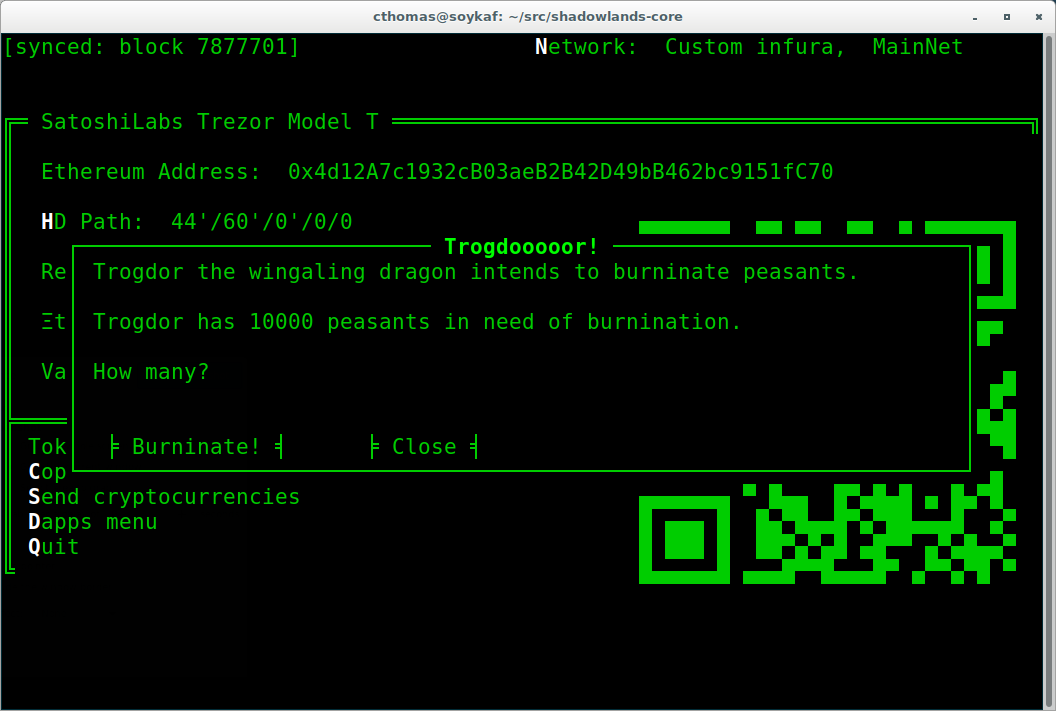
Below we see the result of failing the input validation.
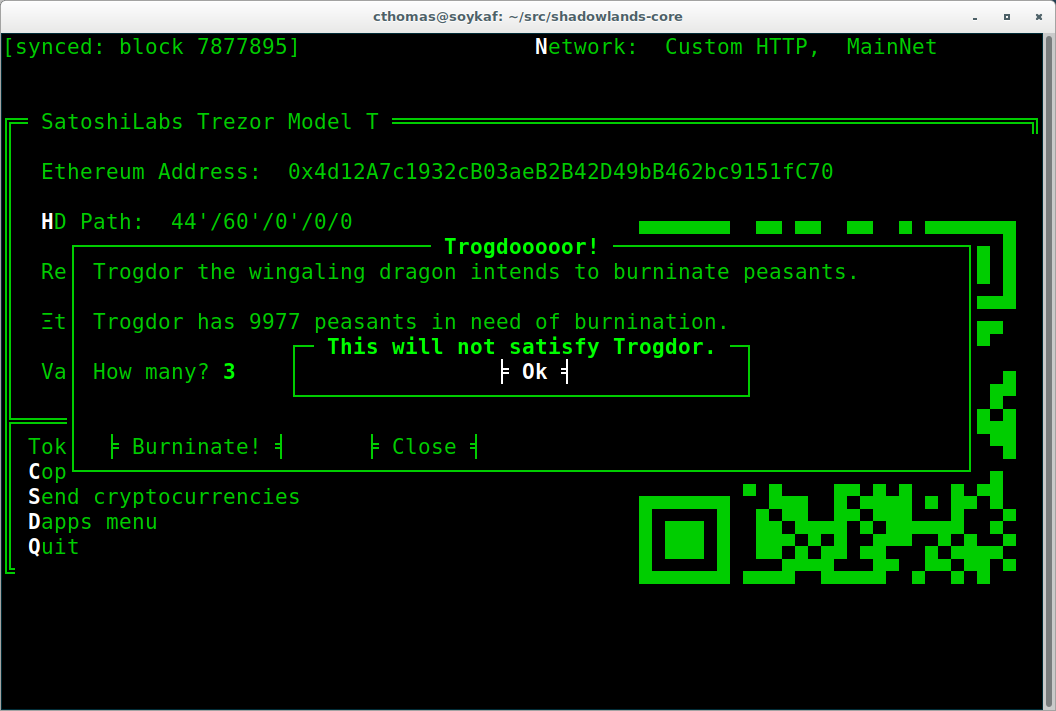
Transactions¶
Let’s get on to burninating some peasants.
from shadowlands.sl_dapp import SLDapp
from shadowlands.sl_frame import SLFrame
from shadowlands.sl_contract.erc20 import Erc20
from decimal import Decimal
from shadowlands.tui.debug import debug, end_debug
import pdb
class Dapp(SLDapp):
def initialize(self):
PEASANT_ADDRESS = '0x8B654789353b0B622667F105eAEF9E97d3C33F44'
self.peasant_contract = Erc20(self.node, address=PEASANT_ADDRESS)
self.peasants = Decimal(self.peasant_contract.my_balance() / (10 ** 18))
self.add_sl_frame(MyMenuFrame(self, height=10, width=70, title="Trogdooooor!"))
class MyMenuFrame(SLFrame):
def initialize(self):
self.add_label("Trogdor the wingaling dragon intends to burninate peasants.")
self.add_label("Trogdor has {} peasants in need of burnination.".format(self.peasants_str))
self.text_value = self.add_textbox("How many?")
self.add_divider()
self.add_button_row([
("Burninate!", self.burninate, 0),
("Close", self.close, 1)
])
@property
def peasants_str(self):
return "{:f}".format(self.dapp.peasants)[:8]
def peasants_validated(self):
try:
self.peasants_to_burninate = Decimal(self.text_value())
except:
self.dapp.add_message_dialog("That number of peasants doesn't make sense.")
return False
if self.peasants_to_burninate > self.dapp.peasants:
self.dapp.add_message_dialog("You don't even *have* that many peasants!")
return False
elif self.peasants_to_burninate < 0.5:
self.dapp.add_message_dialog("This will not satisfy Trogdor.")
return False
return True
def burninate(self):
if not self.peasants_validated():
return
peasantcoins_to_burninate = self.peasants_to_burninate * Decimal(10 ** 18)
burn_fn = self.dapp.peasant_contract.transfer(
'0x00000000000000000000000000000000DeaDBeef',
int(peasantcoins_to_burninate)
)
self.dapp.add_transaction_dialog(
burn_fn,
title="Trogdor burninates the peasantcoins",
gas_limit=56000
)
self.close()
I’ve refactored our input validation to the method peasants_validated on line 30.
So, the time has come for the peasants to meet their final, fiery farewell at the nostrils of the mighty Trogdor.
Note on line 56 that peasant_contract.transfer() returns a method, which we will feed
into add_transaction_dialog() on line 61.
Let’s see how this looks in practice.
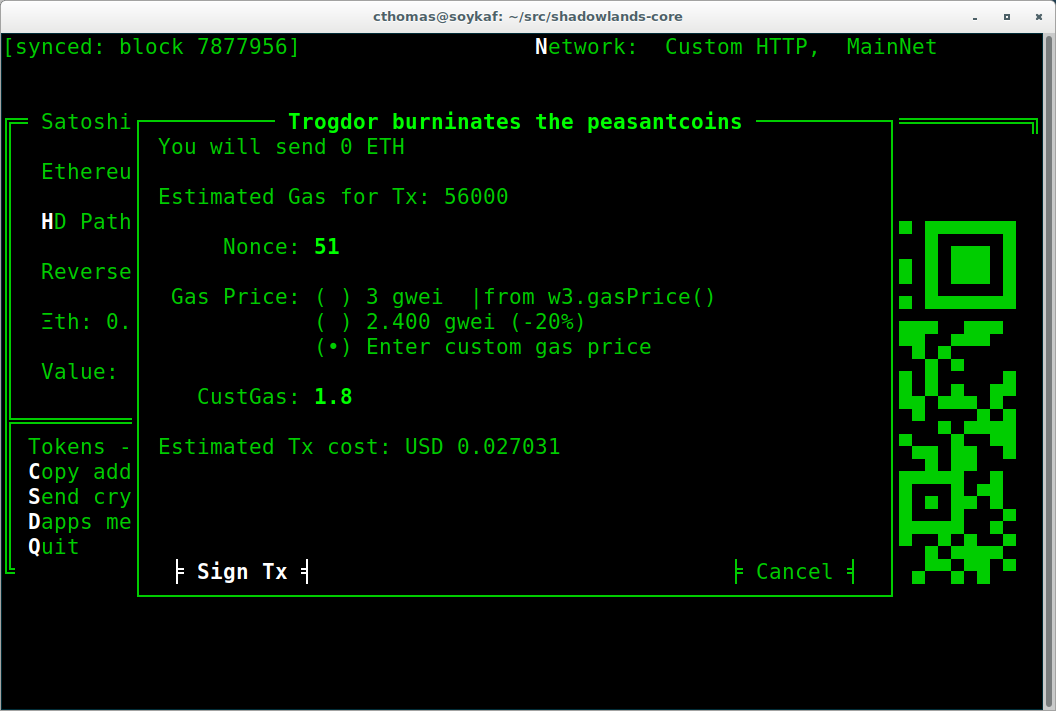
And so, we see there are a few less peasants in the kingdom of peasantry.
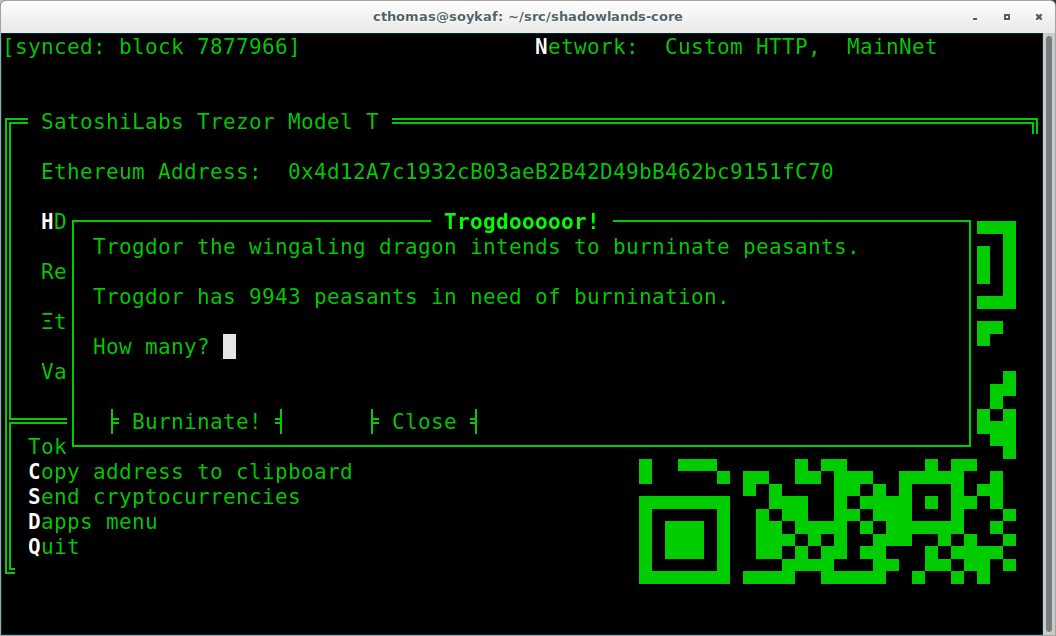
Subclassing Erc20 and SLContract¶
Trogdor is distraught to discover that the peasants have not actually been burninated, but only banished to the cave of 0xdeadbeef. He demands true burnination.
Luckily, the PSNT contract supports burn(), although this is not a standard Erc20
function. Let’s subclass Erc20 and use some of the features of SLContract to make
our lives easier.
from shadowlands.sl_contract.erc20 import Erc20
class PeasantCoin(Erc20):
MAINNET='0x8B654789353b0B622667F105eAEF9E97d3C33F44'
ABI='''
[
{
"constant": true,
"inputs": [],
..(ABI truncated for brevity)...
]
'''
First we create a file called peasant_coin.py in our trogdor directory to house our subclass.
PeasantCoin subclasses Erc20. The default ABI for the
Erc20 subclass doesn’t understand burn(), so we need to supply our own ABI.
Subclassing SLContract (the superclass of Erc20) works the same way - you can
define MAINNET, KOVAN, and other network names that are defined by Node.NETWORK_DICT,
and set these to the deployment address of the contract.
We also can paste the ABI here. See the documentation for SLContract and Erc20 to
fully understand everything they provide.
from shadowlands.sl_dapp import SLDapp
from shadowlands.sl_frame import SLFrame
from trogdor.peasant_coin import PeasantCoin
from decimal import Decimal
from shadowlands.tui.debug import debug, end_debug
import pdb
class Dapp(SLDapp):
def initialize(self):
self.peasant_contract = PeasantCoin(self.node)
self.peasants = Decimal(self.peasant_contract.my_balance() / (10 ** 18))
self.total_peasants = Decimal(self.peasant_contract.totalSupply() / (10 ** 18))
self.add_sl_frame(MyMenuFrame(self, height=12, width=70, title="Trogdooooor!"))
class MyMenuFrame(SLFrame):
def initialize(self):
self.add_label("Trogdor the wingaling dragon intends to burninate peasants.")
self.add_label("There are {} peasants (PSNT) in the world.".format(
self.peasant_decorator(self.dapp.total_peasants)
))
self.add_label("Trogdor has {} peasants in need of burnination.".format(
self.peasant_decorator(self.dapp.peasants)
))
self.text_value = self.add_textbox("How many?")
self.add_divider()
self.add_button_row([
("Burninate!", self.burninate, 0),
("Close", self.close, 1)
])
def peasant_decorator(self, peasants):
return "{:f}".format(peasants)[:12]
We import PeasantCoin on line 3 and instantiate it on line 10. We also grab the totalSupply() on line 12.
Some refactoring into a decorator on line 31 makes things a little nicer.
def burninate(self):
if not self.peasants_validated():
return
peasantcoins_to_burninate = self.peasants_to_burninate * Decimal(10 ** 18)
burn_fn = self.dapp.peasant_contract.functions.burn(
int(peasantcoins_to_burninate)
)
self.dapp.add_transaction_dialog(
burn_fn,
title="Trogdor burninates the peasantcoins",
gas_limit=56000
)
self.close()
On line 7, we access the underlying function generated by web3.py with the functions() method.
Now when we burn PSNT tokens, they will be taken out of the totalSupply().
Uniswap Integration¶
Uh-oh, Trogdor has run out of peasants to burninate. What to do?
Shadowlands has native API integration with Uniswap, so let’s add a button to acquire more PeasantCoin.
class MyMenuFrame(SLFrame):
def initialize(self):
self.add_label("Trogdor the wingaling dragon intends to burninate peasants.")
self.add_label("There are {} peasants (PSNT) in the world.".format(
self.peasant_decorator(self.dapp.total_peasants)
))
self.add_label("Trogdor has {} peasants.".format(
self.peasant_decorator(self.dapp.peasants)
))
self.text_value = self.add_textbox("How many?")
self.add_divider()
self.add_button_row([
("Burninate!", self.burninate, 0),
("Get More Peasants", self.get_peasants, 1),
("Close", self.close, 2)
], layout=[30, 40, 30]
)
def get_peasants(self):
self.dapp.add_uniswap_frame(self.dapp.peasant_contract.address)
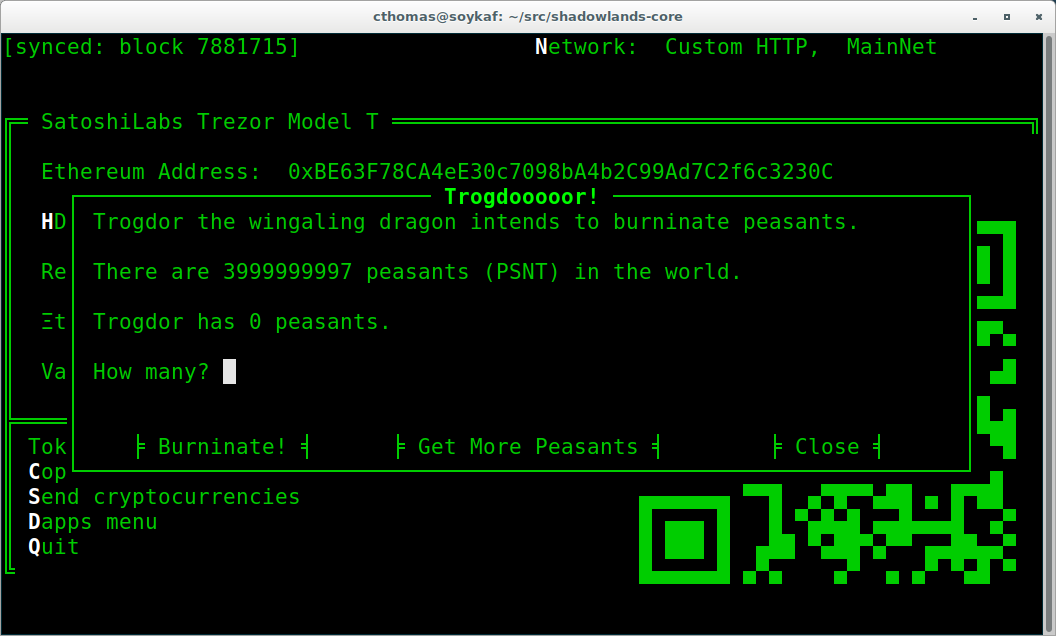
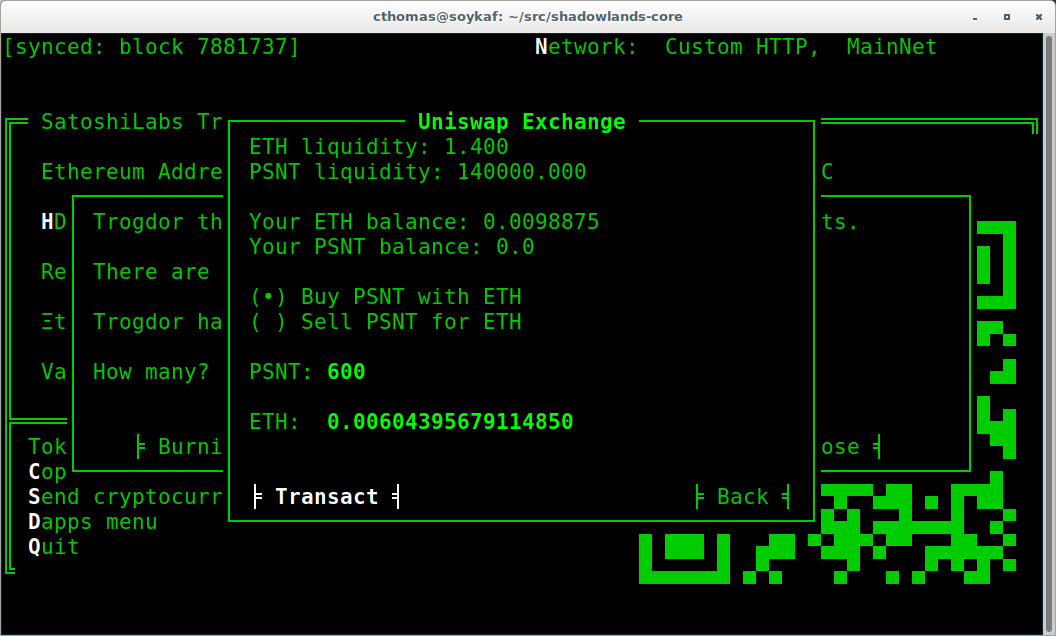
The Hall of Maximum Burnination¶
What’s the use of burninating peasants if nobody knows you did it? Let’s create a leaderboard to show off our incindiary exploits.
There are a lot of additions here, but focus on lines 9 and 10, which checks for the victory condition upon startup.
We define the VictoryFrame class on line 98.
class Dapp(SLDapp):
def initialize(self):
self.token = PeasantCoin(self.node)
self.peasants = Decimal(self.token.my_balance() / (10 ** 18))
self.total_peasants = self.token.totalSupply() / (10 ** 18)
self.my_burninated_peasants = self.token.burninatedBy(self.node.credstick.address) / (10 ** 18)
self.add_sl_frame(MyMenuFrame(self, height=24, width=74))
if self.token.victorious():
self.add_sl_frame(VictoryFrame(self, height=9, width=62, title="Victory!!!"))
class MyMenuFrame(SLFrame):
def initialize(self):
self.add_label("The Hall Of Maximum Burnination", add_divider=False)
self.add_divider(draw_line=True)
self.add_label("Rank Peasants Hero", add_divider=False)
for heroes in self.top_burninators_decorator():
self.add_label(heroes, add_divider=False)
self.add_divider(draw_line=True)
self.add_label("Trogdor the wingaling dragon intends to burninate peasants.", add_divider=False)
self.add_label("There are {} peasants (BRNT) in the world.".format(self.peasant_decorator(self.dapp.total_peasants)))
self.add_label("Trogdor has {} peasants, and has burninated {}".format(self.peasant_decorator(self.dapp.peasants), self.peasant_decorator(self.dapp.my_burninated_peasants)))
self.text_value = self.add_textbox("How many to burninate?", default_value=' ')
self.add_button_row([
("Burninate!", self.burninate, 0),
("Get More Peasants", self.get_peasants, 1),
("Close", self.close, 2)
], layout=[30, 40, 30]
)
def top_burninators_decorator(self):
burninators = self.dapp.token.top_burninators()
i = 0
heroes = []
#debug(); pdb.set_trace()
for hero in burninators:
hero_name = self.dapp.node._ns.name(hero[0])
if hero_name is None:
hero_name = hero[0]
heroes.append("{} {:14s} {}".format(i, self.peasant_decorator(hero[1]), hero_name))
i += 1
if len(heroes) < 10:
for x in range(len(heroes), 10):
heroes.append(
"{} Unclaimed".format(str(x)))
return heroes
def peasant_decorator(self, peasants):
return "{:f}".format(peasants)[:14]
def get_peasants(self):
self.dapp.add_uniswap_frame(self.dapp.token.address)
def peasants_validated(self):
try:
self.peasants_to_burninate = Decimal(self.text_value())
except:
self.dapp.add_message_dialog("That number of peasants doesn't make sense.")
return False
if self.peasants_to_burninate > self.dapp.peasants:
self.dapp.add_message_dialog("You don't even *have* that many peasants!")
return False
elif self.peasants_to_burninate < 0.5:
self.dapp.add_message_dialog("This will not satisfy Trogdor.")
return False
return True
def burninate(self):
if not self.peasants_validated():
return
tokens_to_burninate = self.peasants_to_burninate * Decimal(10 ** 18)
burn_fn = self.dapp.token.burninate(
int(tokens_to_burninate)
)
self.dapp.add_transaction_dialog(
burn_fn,
title="Trogdor burninates the tokens",
gas_limit=56000
)
self.close()
class VictoryFrame(SLFrame):
def initialize(self):
self.add_label("Congratulations! You have racked up a truly impressive", add_divider=False)
self.add_label("count of {} burninated peasants, as well".format(self.peasant_decorator(self.dapp.my_burninated_peasants)), add_divider=False)
self.add_label("as several incinerated thatched roof cottages and various", add_divider=False)
self.add_label("counts of petty theft and vandalism. Your throne in the", add_divider=False)
self.add_label("Hall of Maximum Burnination awaits your Dragonly Personage!")
self.add_button_row(
[("Claim Victoriousness", self.claim_victory, 0),
("Back", self.close, 1)],
layout=[50, 50],
)
def claim_victory(self):
self.dapp.add_transaction_dialog(
self.dapp.token.claimVictory(),
title="Claiming victory",
gas_limit=100000
)
self.close()
def peasant_decorator(self, peasants):
return "{:f}".format(peasants)[:14]
A closer look at the peasantcoin contract¶
The Erc20 class and its SLContract base class give you a great deal of
functionality for free, but it’s often useful to add on some extra
methods that have close connection to our contract calls.
The self.functions() is an easy way to get at the underlying
function of the web3.py contract class.
Erc20 subclasses also provide passthrough methods to all standard
erc20 functions, as well as helper methods like my_balance()
from shadowlands.sl_contract.erc20 import Erc20
from shadowlands.tui.debug import debug, end_debug
from decimal import Decimal
import pdb
class PeasantCoin(Erc20):
### Passthrough calls to contract
# Similar to balanceOf, but keeps track of burninated peasants
def burninatedBy(self, address):
return self.functions.burninatedBy(address).call()
def topBurninators(self):
return self.functions.topBurninators().call()
### Helper methods
def my_burninated_peasants(self):
return self.burninatedBy(self.node.credstick.address)
def top_burninators(self):
'''
Returns a sorted list of lists of integers and addresses,
representing the top burninators. Maximum 10 results.
'''
burninators = set(self.topBurninators())
burninators.remove('0x0000000000000000000000000000000000000000')
if len(burninators) == 0:
return []
burninators = [[x, Decimal(self.burninatedBy(x)) / (10 ** 18)] for x in list(burninators)]
burninators.sort(key=lambda x: x[1], reverse=True)
return burninators
def victorious(self):
'''
Returns True or False.
True only if user is not currently in the hall but is
allowed to take a spot.
'''
if self.my_burninated_peasants() == 0:
return False
# Are we already in the hall of max burnination?
if self.node.credstick.address in [self.topBurninators()]:
return False
if len(top) < 10:
return True
# Weakest burninator first
top = self.top_burninators()
top.sort(key=lambda x: x[1])
if top[0][1] < Decimal(self.my_burninated_peasants()) / 10 ** 18:
return True
return False
### TXs
def burninate(self, peasants):
return self.functions.burn(peasants)
def claimVictory(self):
return self.functions.claimVictory()
ABI='''
[{"name":"Transfer","inputs":[{"type":"addre...
'''
Here is the hall of Maximum Burnination, in all its glory:
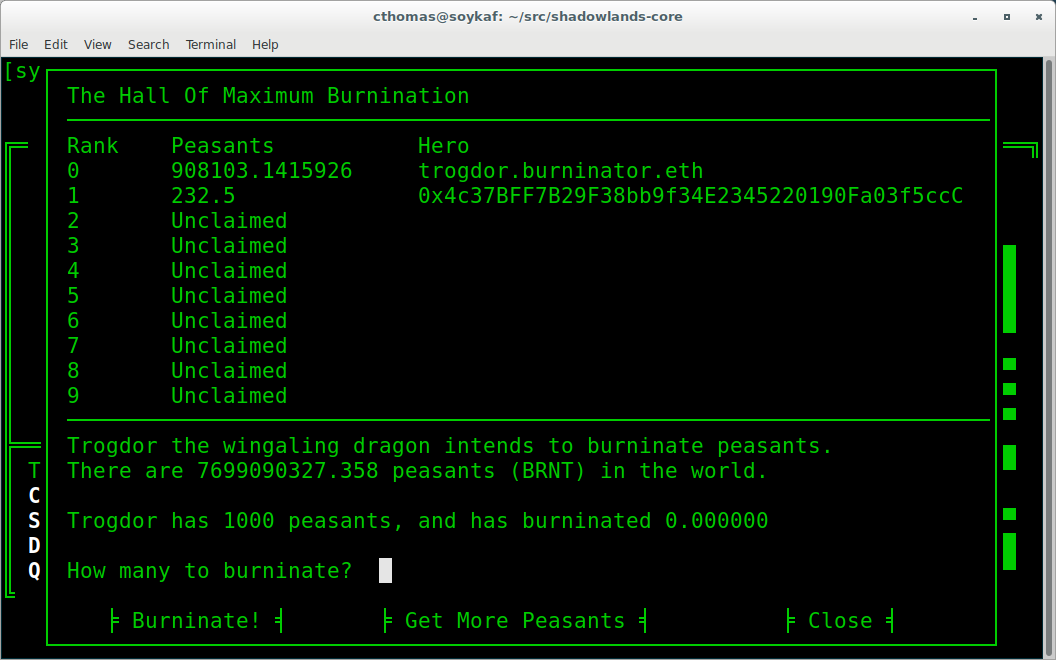
And so, 133 fiery peasants later (and after restarting the dapp)…
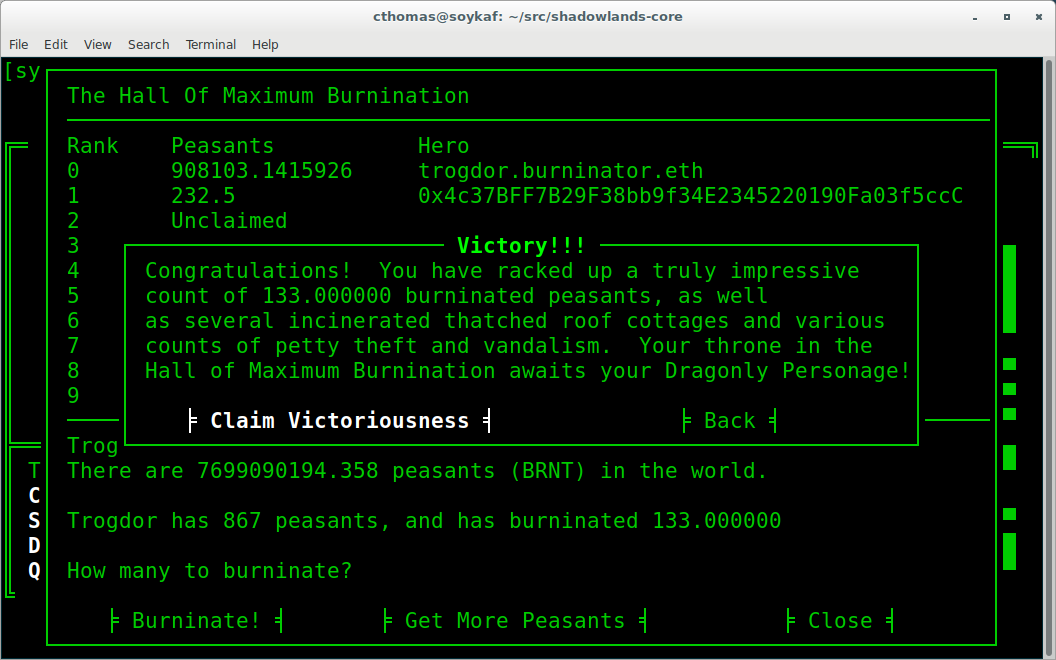
And so, after the transaction is run and we restart the app…
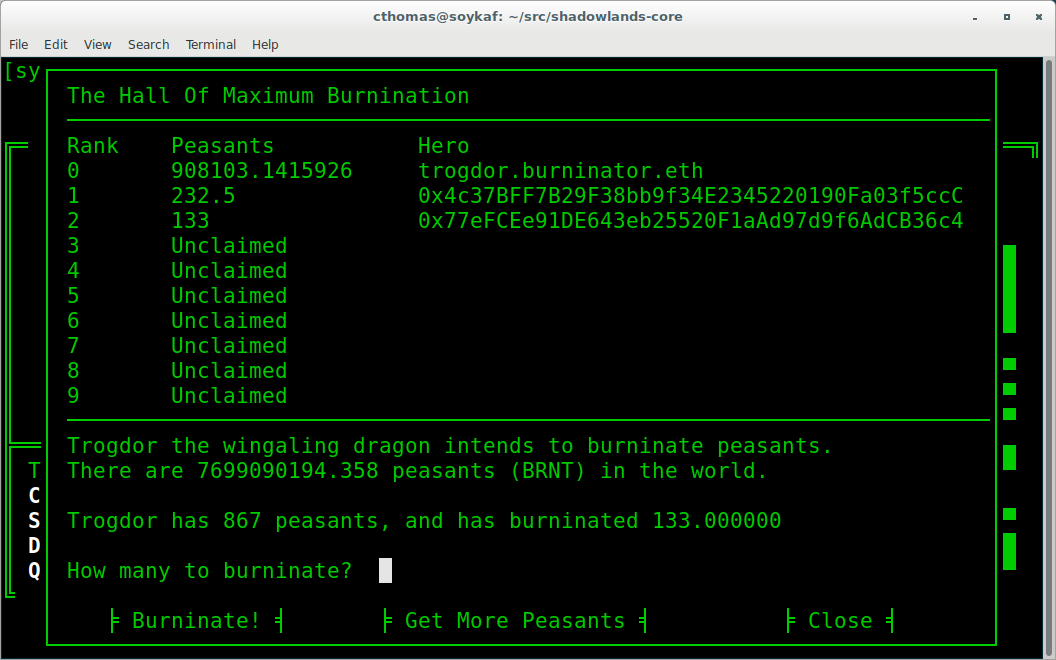
Huzzah! We are immortal - for the time being.
Making your dapp update dynamically¶
It’s hella lame that we have to keep restarting the app in order to react to changes on the blockchain. Luckily, help is on the way.
The label widgets on shadowlands can take either a string, or a function reference (or lambda) that returns a string. That will let us make the displays dynamic, but it also can make your dapp VERY SLOW.
To help solve this performance problem, the SLDapp and SLFrame classes
will automatically expire the cache on any @cached_property
when a new block appears.
Using lambdas to cached properties as input to labels combines the best of both worlds - any function reference you pass to a label will be both dynamic and reasonably performant.
In addition, SLDapp and SLFrame will both trigger the new_block_callback()
which you can override for your own purposes. This callback will be called
immediately after the cached properties are expired,
Let’s put our informational display strings in cached properties to let
the app update dynamically. We can also implement new_block_callback()
to make the victory frame pop up when appropriate.
from shadowlands.sl_dapp import SLDapp
from shadowlands.sl_frame import SLFrame
from burninator.peasant_coin import PeasantCoin
from decimal import Decimal
from cached_property import cached_property
from shadowlands.tui.debug import debug, end_debug
import pdb
class Dapp(SLDapp):
def initialize(self):
self.token = PeasantCoin(self.node)
self.add_sl_frame(MyMenuFrame(self, height=24, width=74 ))
self.victory_notification_has_been_seen = False
self.victory_check()
def victorious_check(self):
if self.victory_notification_has_been_seen:
return
if self.token.victorious():
self.add_sl_frame(VictoryFrame(self, height=9, width=62, title="Victory!!!"))
self.victory_notification_has_been_seen = True
def new_block_callback(self):
self.victory_check()
@cached_property
def total_peasants(self):
return self.token.totalSupply() / (10 ** 18)
@cached_property
def my_burninated_peasants(self):
return self.token.burninatedBy(self.node.credstick.address) / (10 ** 18)
@cached_property
def peasants(self):
return Decimal(self.token.my_balance() / (10 ** 18))
def peasant_decorator(self, peasants):
return "{:f}".format(peasants)[:14]
Here we implement new_block_callback() and use it to call victory_check(). It may be
useful to know that new_block_callback() is called immediately after the cache is expired.
On line 5 we import the cached_property decorator.
We declare most of the dapp variables as @cached_property now - this will let them update
dynamically, as well as keeping performant when any other classes in the dapp need to reference them.
class MyMenuFrame(SLFrame):
def initialize(self):
self.add_label("The Hall Of Maximum Burnination", add_divider=False)
self.add_divider(draw_line=True)
self.add_label("Rank Peasants Hero", add_divider=False)
for i in range(10):
self.add_label(self.burninator_hero(i), add_divider=False)
self.add_divider(draw_line=True)
self.add_label("Trogdor the wingaling dragon intends to burninate peasants.", add_divider=False)
self.add_label(lambda: self.total_peasants_string)
self.add_label(lambda: self.my_peasant_status_string)
self.text_value = self.add_textbox("How many to burninate?", default_value=' ')
self.add_button_row([
("Burninate!", self.burninate, 0),
("Get More Peasants", self.get_peasants, 1),
("Close", self.close, 2)
], layout=[30, 40, 30]
)
@cached_property
def total_peasants_string(self):
return "There are {} peasants (BRNT) in the world.".format(self.dapp.peasant_decorator(self.dapp.total_peasants))
@cached_property
def my_peasant_status_string(self):
return "Trogdor has {} peasants, and has burninated {}".format(self.dapp.peasant_decorator(self.dapp.peasants), self.dapp.peasant_decorator(self.dapp.my_burninated_peasants))
def burninator_hero(self, index):
return lambda: self.top_burninators_decorator[index]
@cached_property
def top_burninators_decorator(self):
burninators = self.dapp.token.top_burninators()
i = 0
heroes = []
for hero in burninators:
hero_name = self.dapp.node._ns.name(hero[0])
if hero_name is None:
hero_name = hero[0]
heroes.append("{} {:14s} {}".format(i, self.dapp.peasant_decorator(hero[1]), hero_name))
i += 1
if len(heroes) < 10:
for x in range(len(heroes), 10):
heroes.append(
"{} Unclaimed".format(str(x)))
return heroes
The magic happens on lines 12 and 13, where we send a lambda: self.property_name into the labels.
I had to get a little bit fancy at line 8 and call a function to return
lambdas that index the array returned by the cached property top_burninators_decorator.
And now our app updates live.
Tutorial Source Code¶
The source code for the Burninator app is available on github at https://github.com/kayagoban/burninator
Deploying your dapp¶
Shadowlands has a package management contract at sloader.shadowlands.eth that allows you to deploy your dapp
so you can share it with the world.
Once registered, anyone can run your dapp by using the ethereum address you used to register the software (they can also reference your ENS, which is much nicer). If you want to register more than one dapp, use a different address to register each.
In this example, I am using address 0x4c37BFF7B29F38bb9f34E2345220190Fa03f5ccC which is
is resolved by the ENS name burninator.eth.
Select the Deploy local dapp to network from the Dapps menu.
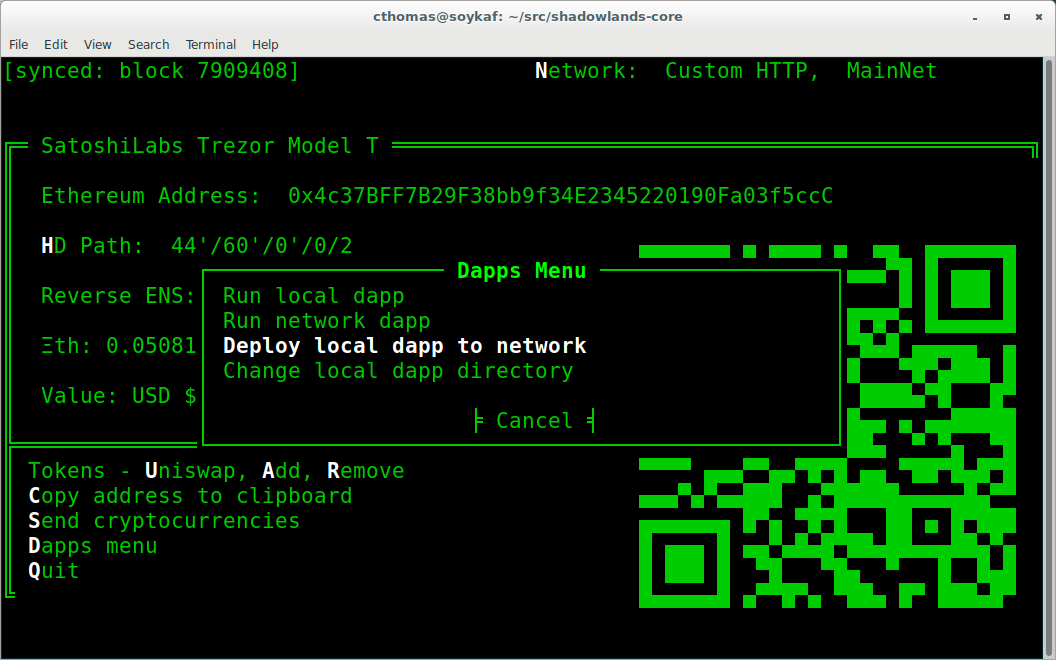
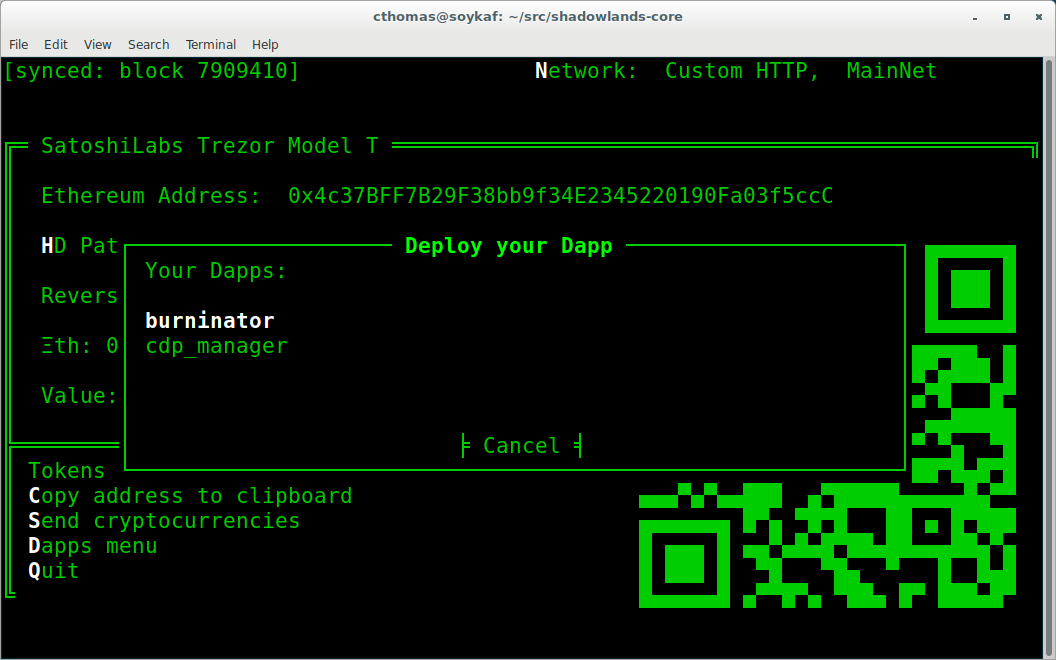
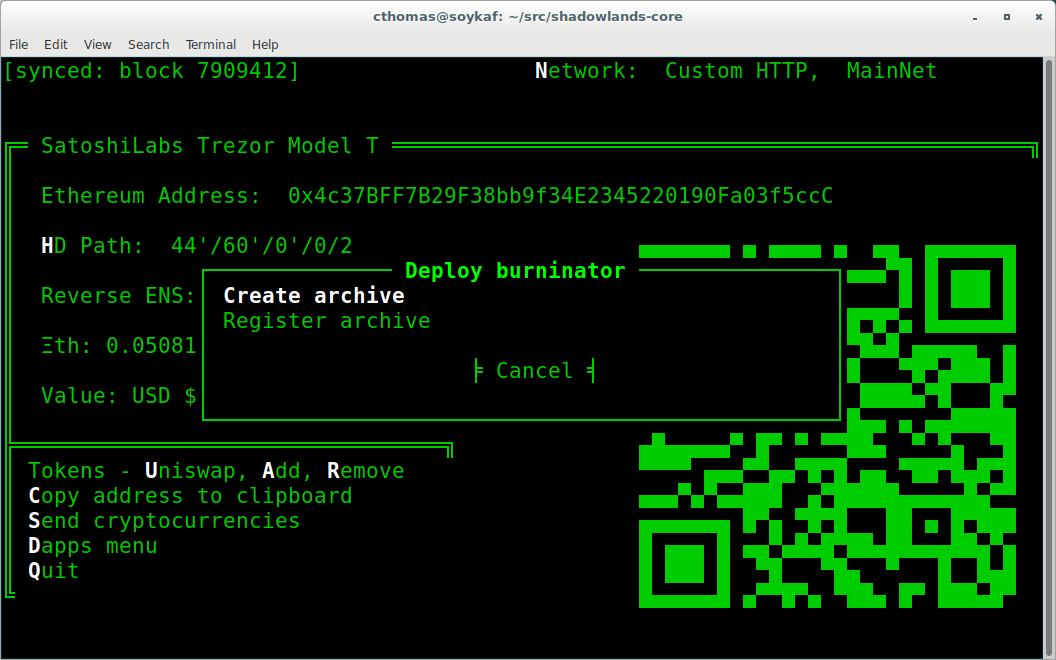
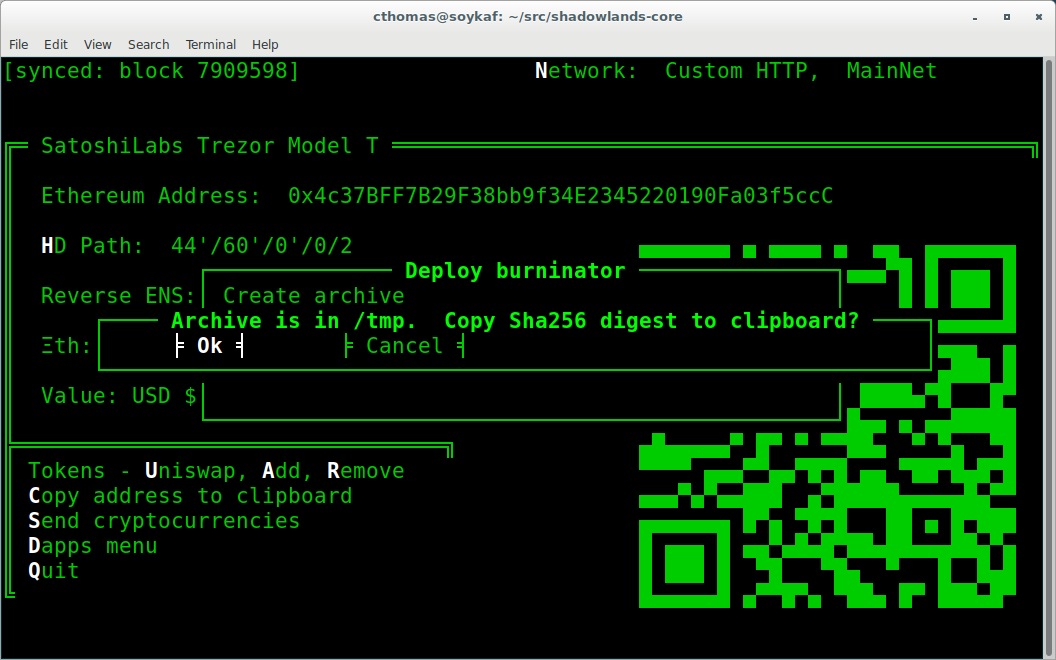
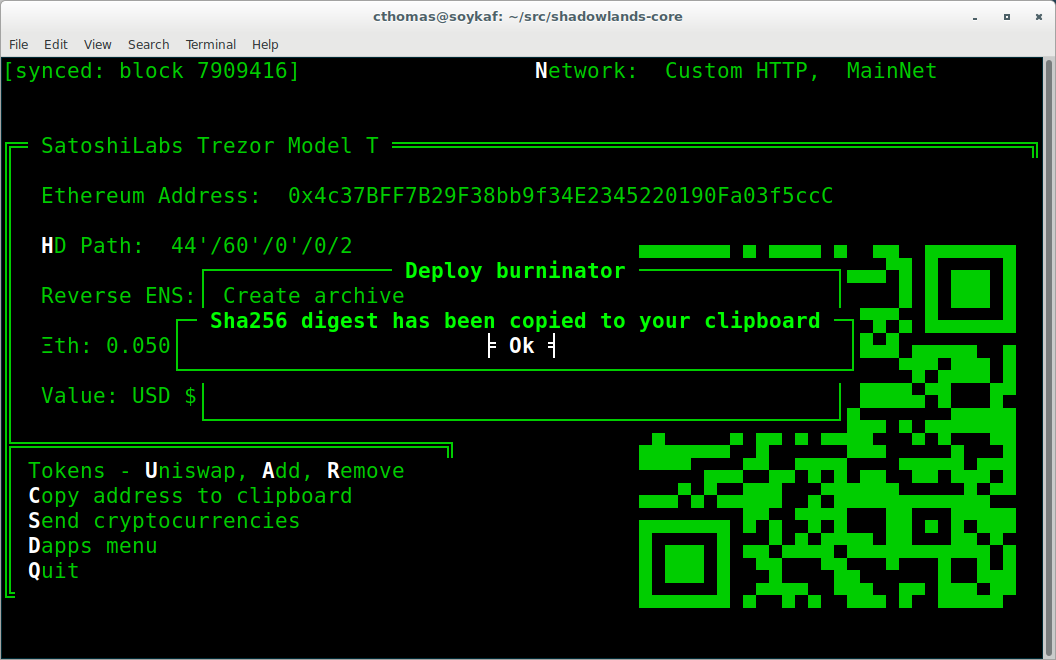
Now, copy the zip file to some place on the internet. Do not use the zip files generated by github releases - for some reason the ZipImporter class does not accept them as legit zip files. You can add the shadowlands-generated zip file to a github release though - this is an easy way to get free hosting.
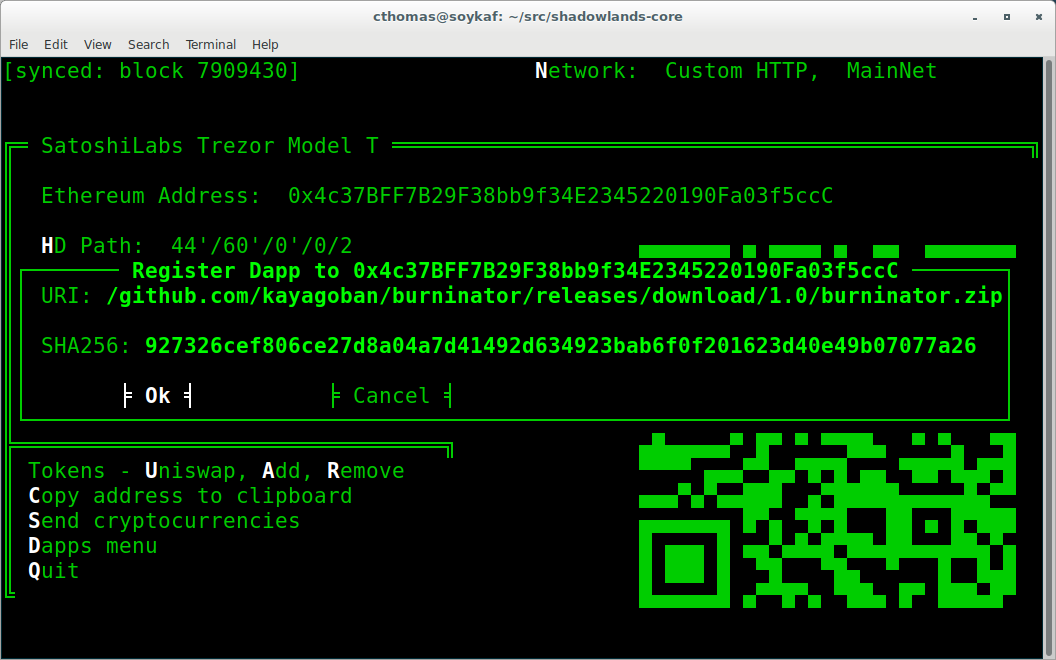
Now you will register this URL and checksum. Once the TX is mined, anyone can run your app:
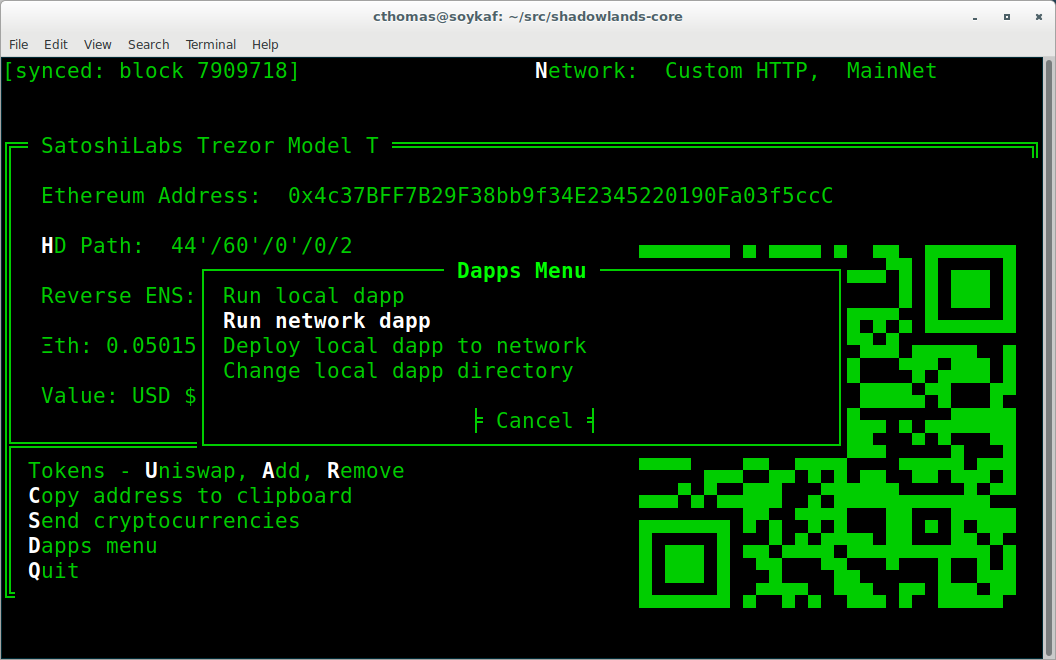
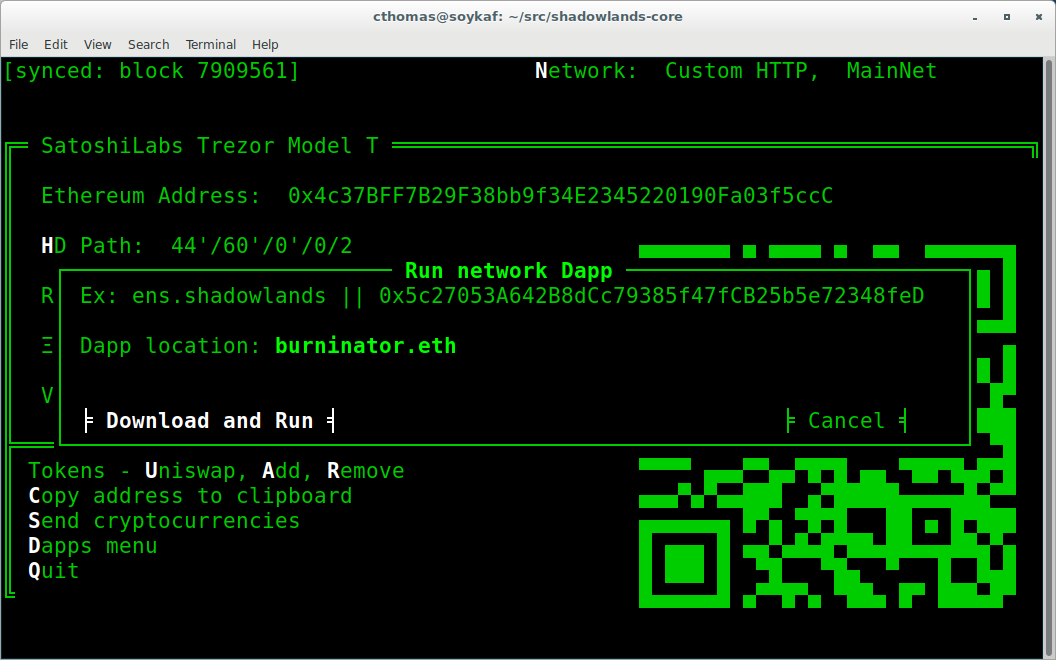
And there we are!
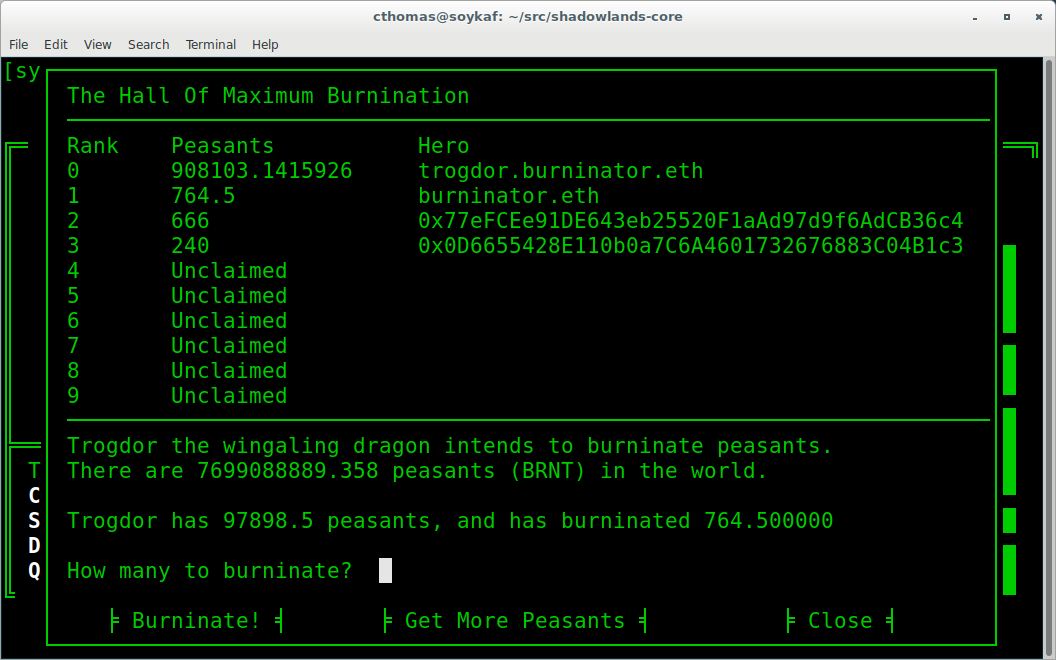
Disclaimer¶
No peasants were harmed during the writing of this tutorial.